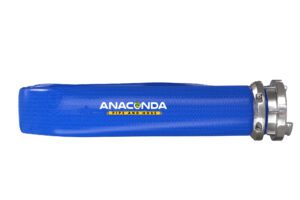Drag Hose by Anaconda is a high performance flexible lay flat hose for sludge injections, and transfer of slurries, liquid manure and municipal sludge.
Home
Lay Flat Hose
Drag Hose
Drag Hose Lay Flat Hose
Drag Hose by Anaconda, a versatile and durable large-diameter hose specifically designed for efficient sludge injection and slurry transfer applications, making it the optimal choice for pumping liquid manure and municipal sludge. Engineered for agricultural operations, this flexible lay-flat hose is capable of handling both continuous and intermittent high-pressure operations with ease.
Our dedicated sales team is prepared to discuss the numerous advantages of integrating a dependable and robust drag hose into your manure application systems. Utilizing a through-the-weave manufacturing technique, Anaconda Drag Hose eliminates concerns of de-lamination and significantly reduces friction loss compared to aluminum or PVC pipes, thereby lowering overall pumping costs.
This agricultural and municipal drag hose boasts the unique ability to expand in diameter under pressure, allowing for extended pumping distances and increased flow rates of liquid manure and other fluids. Every aspect of its raw materials, components, and finished products undergoes rigorous testing and inspection to ensure unmatched reliability and performance in demanding environments.
Experience the reliability and efficiency of Anaconda Drag Hose—designed to meet and exceed the challenges of modern agricultural and municipal slurry transfer needs.
Primary Uses & Applications: Sludge injection, slurry transfer, municipal sludge, liquid manure.
Color Options: Orange (standard)
Lengths and Diameters: Depending on the version, we offer a range of diameters and lengths for this hose. The diameters range from 5″ (125mm) to 7-1/4″ (184mm), and for some diameters, the hose can be delivered in lengths of 50ft, 100ft, or up to 6600ft (2011m).
Technical Details
Size inch (mm) | Working Pressure psi (kpa) | Burst Pressure psi (kpa) | End Tensile Strength lbs (kg) | Weight lbs/ft (kg) | Get Pricing |
|---|---|---|---|---|---|
5 (125) | 250 (1724) | 500 (3447) | 40000 (18181) | 1.15 (0.52) | |
5-1/2 (140) | 250 (1724) | 500 (3447) | 46000 (20909) | 1.26 (0.57) | |
6 (150) | 250 (1724) | 500 (3447) | 46000 (20909) | 1.60 (0.73) | |
7-1/4 (184) | 250 (1724) | 500 (3447) | 70000 (31818) | 1.90 (0.86) |
Get Drag Hose Lay Flat Pricing Now!
Talk to our experts about Drag Hose lay flat hose for your current or next project.
Call us now or fill out our request form for a prompt estimate.
Lay Flat Hose Rentals
Many Anaconda customers use our HDPE pipe solutions for temporary or short term projects. We offer the flexibility of renting our pipe and hose solutions to ensure that once a project is complete, the equipment can be returned with relative ease. Please contact us for details.
Lay flat hoses, also known as discharge hoses or backwash hoses, are commonly used in various industrial applications due to their unique design and advantageous features. These hoses are constructed to be flexible and flat when not in use, but they expand and provide efficient fluid conveyance when pressurized. The benefits of lay flat hoses for industrial applications are numerous and include:
- Compact Storage: One of the primary advantages of lay-flat hoses is their ability to be stored compactly. These hoses can be rolled up or folded flat when not pressurized, minimizing storage space requirements. This feature is particularly beneficial in industries where space optimization is crucial.
- Easy Handling and Deployment: Lay flat hoses are lightweight and easy to handle, making them convenient for quick deployment in various industrial settings. Their flexibility allows for straightforward maneuverability, reducing the time and effort required for installation and repositioning.
- Quick Setup and Retrieval: The flat design of these hoses facilitates rapid deployment and retrieval. This is especially advantageous in emergencies or applications where time efficiency is critical, such as firefighting, irrigation, or temporary fluid transfer operations.
- Reduced Risk of Kinking and Tangling: Traditional hoses can be prone to kinking and tangling, which can impede fluid flow and lead to inefficiencies. Lay flat hoses, with their flat design, are less susceptible to kinking and tangling, ensuring a smooth and uninterrupted fluid transfer process.
- High Flow Capacity: Lay flat hoses are engineered to have a larger internal diameter than other types of hoses. This design feature contributes to high flow capacity, enabling the efficient transfer of liquids, slurries, or chemicals in industrial applications where a substantial fluid volume needs to be moved.
- Durability and Longevity: These hoses are typically constructed from robust materials such as synthetic nitrile rubber or PVC, which makes them resistant to abrasion, chemicals, and UV exposure. This durability ensures a longer operational lifespan, reducing the frequency of replacements and maintenance costs.
- Versatility in Applications: Lay flat hoses find applications in various industrial sectors, including agriculture, construction, mining, oil and gas, and firefighting. Their adaptability to different fluids and environments makes them versatile for various fluid transfer needs.
- Cost-Effective Solution: The durability, ease of handling, and efficient fluid transfer capabilities of lay flat hoses contribute to a cost-effective solution for many industrial applications. Reducing labor time, maintenance, and the need for additional equipment makes them an economical choice for fluid conveyance.
In summary, lay-flat hoses offer a practical and efficient solution for industrial fluid transfer needs. They combine ease of use, versatility, and cost-effectiveness. Their unique design and advantageous features make them a preferred choice in numerous industrial settings.
Frequently Asked Questions
Welcome to our Lay Flat Hose FAQ section. Here, we address common queries about our high-quality industrial lay flat hoses which are designed for robust service in various applications. If you have additional questions, feel free to contact our experts for personalized assistance.
What is an industrial lay flat hose?
Answer: An industrial lay flat hose is a flexible, collapsible hose designed for efficient fluid transfer. Its flat design allows for easy storage and transport when not in use.
What materials are lay flat hoses made from?
Answer: Lay flat hoses are commonly made from PVC, polyurethane, or nitrile rubber. Material choice depends on factors like chemical compatibility, flexibility, and durability.
How do lay flat hoses differ from traditional hoses?
Answer: Lay flat hoses distinguish themselves by their flat, collapsible design, making them easy to store. They are typically lightweight and flexible, suitable for temporary or portable fluid transfer.
What are the most critical advantages of lay flat hoses?
Answer: Lay flat hoses offer benefits such as ease of handling, quick deployment, kink resistance, and the ability to cover large areas. They are also cost-effective and easy to transport.
Can lay flat hoses handle high-pressure applications?
Answer: Lay flat hoses are generally designed for low to medium-pressure applications. Specialized versions with reinforced layers may handle higher pressures, but choosing the right type for the application is crucial.
Can lay flat hoses handle abrasive materials?
Answer: Lay flat hoses can handle some abrasion, but using reinforced industrial hoses with specialized abrasion-resistant materials is recommended for abrasive applications.
What considerations are important when selecting lay flat hoses?
Answer: Consider factors like material compatibility, pressure requirements, temperature range, flexibility, and abrasion resistance. Choose hoses that meet industry standards and are suitable for the specific application.
Are lay flat hoses suitable for potable water applications?
Answer: Yes, lay flat hoses made from materials approved for potable water use are available. Always check the hose specifications and certifications to ensure compliance with drinking water standards.
How do I determine the right size of lay flat hose for my application?
Answer: Consider the required flow rate, pressure, and the distance the hose must cover. Consult manufacturer specifications and charts to choose the appropriate diameter and length for optimal performance.
How do I determine the right size of lay flat hose for my application?
Answer: Consider the required flow rate, pressure, and the distance the hose must cover. Consult manufacturer specifications and charts to choose the appropriate diameter and length for optimal performance.
What maintenance is required for industrial suction hoses?
Answer: Regular inspection for wear, damage, or deterioration is essential. Proper storage away from sunlight and chemicals, along with correct fittings and couplings, contributes to longevity.
Are lay flat hoses suitable for transferring chemicals?
Answer: Depending on the material composition, lay flat hoses can be suitable for chemical transfer. Verifying chemical compatibility and choosing hoses designed for chemical applications is essential.
How do you store and maintain lay flat hoses?
Answer: Store hoses flat, away from direct sunlight and extreme temperatures. Regularly inspect for abrasions, punctures, or kinks. Clean hoses after use and follow manufacturer guidelines for maintenance.




